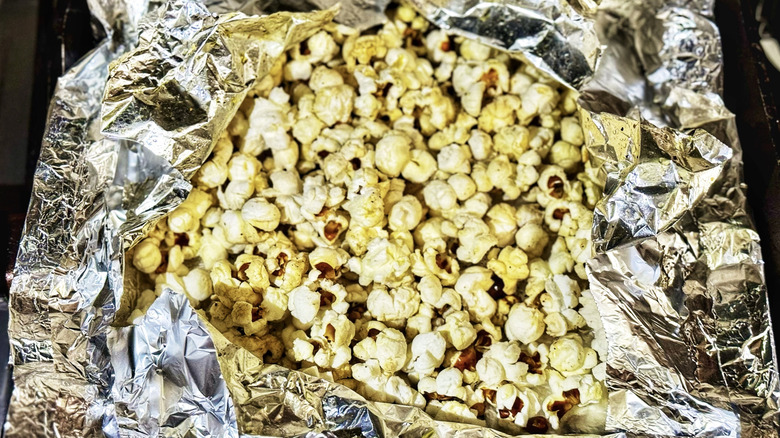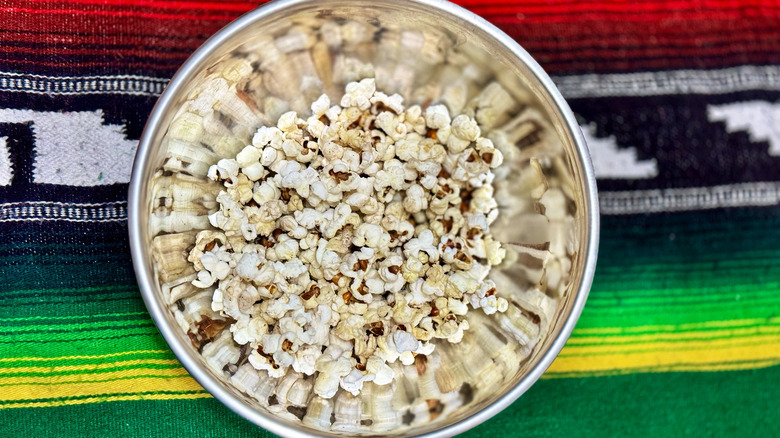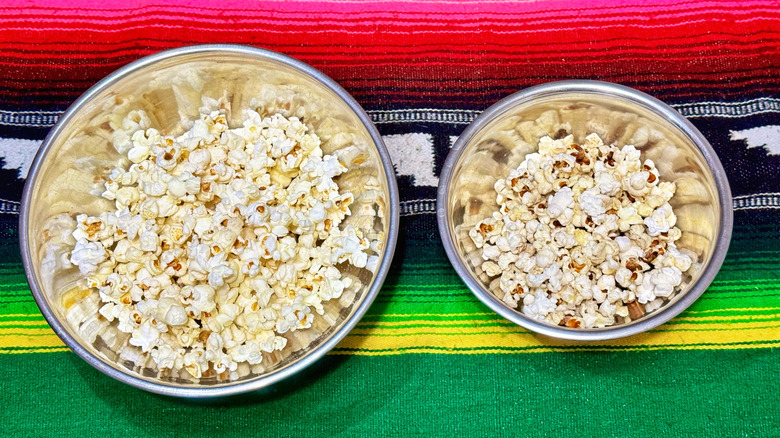TikTok's Viral Popcorn Hack Is A Waste Of Foil
Popcorn has been around since before Europeans arrived in the Americas. Simple yet tasty, the snack is almost universally beloved, especially now that microwaves have made it possible for us to enjoy it with minimal effort and o=in record time. Not everyone loves the microwave, though, which is why some people like the idea of returning to the good ol' stovetop ways. There's a viral hack circulating different social media channels that involves wrapping unpopped popcorn kernels in aluminum foil and cooking them on the stovetop. Its proponents say it's the simplest home popping method, but I admit I was immediately skeptical about it.
Since I tend to move around a lot, I don't always have access to a microwave and have gotten used to not using it much. Even when I do have a microwave, I usually just use the stovetop when I'm craving popcorn—and I've never needed aluminum foil. But sometimes internet cooks are right, and their hacks often make our lives simpler. Is foil superior? Would influencers prove that my popcorn method has been lacking this whole time?
To settle the matter, I decided to go the scientific route and test both methods myself. This high-stakes experiment needed to be rigorous. After all, it could potentially change how I make popcorn for the rest of my life. Here's how it went.
Making stovetop popcorn with aluminum foil
I saw the foil hack on an Instagram page that was testing it based on another video. The user definitely seemed happy, and the reel made it seem easy. However, she didn't give any measurements or heat intensity instructions, so I turned to a more detailed TikTok video for those. Both used popcorn kernels (of course), butter (I went with salted), and aluminum foil.
To make popcorn this way, you have to place a sheet of foil on a flat surface and pour around 1/4 cup of kernels on top. Add a small cube of butter on top and sprinkle everything with salt. Then, cover everything with a second sheet of foil, fold the edges to seal it, and poke a hole in the middle. Gently shake the foil so the kernels are distributed more evenly. Once everything is ready, simply put the foil packet on a pan or in a pot and heat it over medium heat.
At this point, you wait. And wait. And wait. It took almost 12 minutes for the popcorn to start popping. Once it got going, it took another 10 minutes until the pops slowed down. I opened the foil and poured everything into a bowl only to realize there were several popcorn kernels that hadn't popped. The ones that had popped were slightly burnt, probably because the entire process had taken way too long.
Making stovetop popcorn the traditional way
Once I'd finished the first underwhelming batch, I made another batch with my usual recipe. For this method, you don't need foil, only kernels, salt, and oil. I did add butter as well so that the taste would be similar to that of the foil method.
To use this method, pour the kernels into a medium-sized pot (or a larger one if you're using more kernels), then pour enough oil to cover around half of the kernels. Add the butter on top, but don't salt anything yet, and turn on the heat. Grabbing the pot by both handles, gently move it around so that the oil and butter distribute evenly. Keep moving it periodically as the kernels start turning a lighter shade of yellow. When the first kernel pops, put the lid on the pot. At this point, you'll want to shake the pot a bit more vigorously around every 45 seconds. This guarantees that any unpopped kernels stuck on top will drop to the bottom and cook. When there's a two to three second space between pops, turn off the heat and pour the popcorn in a bowl. Immediately salt it, since the heat will help your popcorn seasoning stick.
This batch of popcorn came out fluffy and unburnt. There was not a single unpopped kernel, and the taste was better than that of the first batch.
Is the foil popcorn hack worth it?
The foil method is one of the worst cooking hacks I have ever tried. Instead of solving problems, it creates them, and offers few benefits besides doing away with the need to shake the pot. Using foil means extra steps, extra ingredients, and extra waste. You have to create a little foil cocoon, but the only thing this does is prevent you from checking how your popcorn is doing. The taste was subpar, since the popcorn turned out a bit burnt. This method took 22 minutes and 46 seconds — an absurdly long time for a snack that's supposed to be easy and fast.
On the other hand, the traditional method is simpler, tastes better, and is way faster. It took only 4 minutes and 54 seconds for me to get deliciously fluffy popcorn. I also love that with this method, you can just open the lid to check whether the snack is cooking correctly. Yes, you have to be more on top of it, and you have to shake it, but this really isn't a huge deal, especially since the result is almost always being able to pop every single kernel. If I were to change anything about this method, it would maybe be experimenting with using ghee instead of oil. Other than that, I'll ignore social media and stick to the tried, true, and superior method. I'd advise everyone to do the same.



